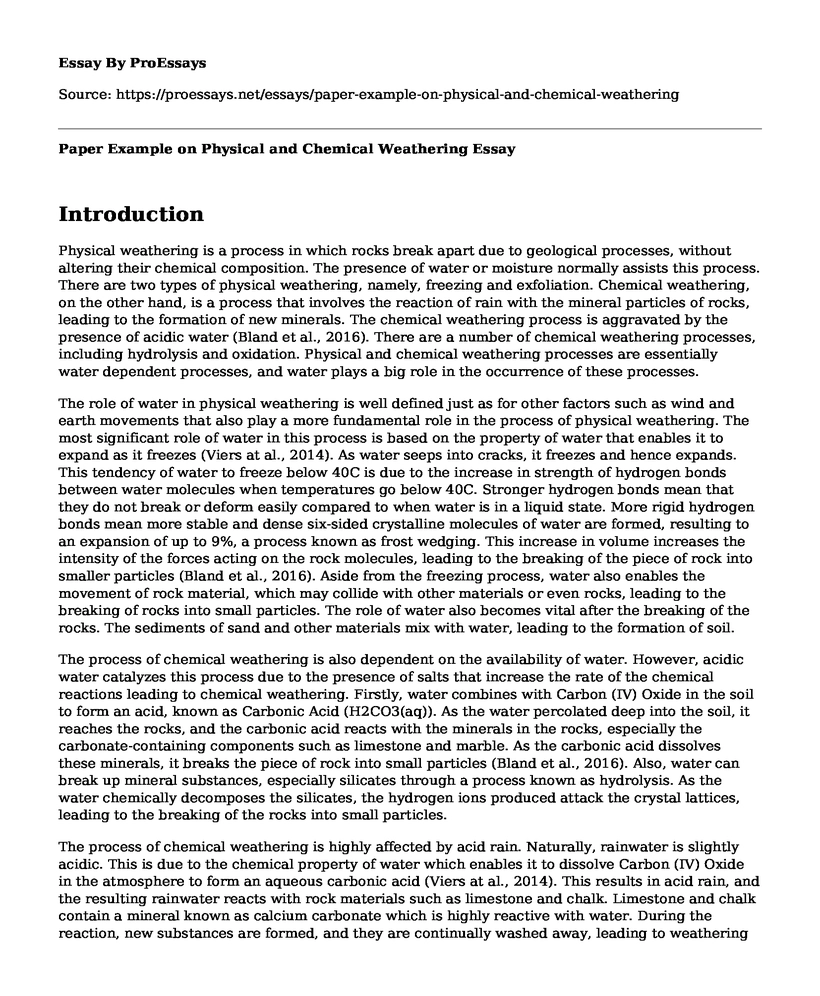Introduction
Physical weathering is a process in which rocks break apart due to geological processes, without altering their chemical composition. The presence of water or moisture normally assists this process. There are two types of physical weathering, namely, freezing and exfoliation. Chemical weathering, on the other hand, is a process that involves the reaction of rain with the mineral particles of rocks, leading to the formation of new minerals. The chemical weathering process is aggravated by the presence of acidic water (Bland et al., 2016). There are a number of chemical weathering processes, including hydrolysis and oxidation. Physical and chemical weathering processes are essentially water dependent processes, and water plays a big role in the occurrence of these processes.
The role of water in physical weathering is well defined just as for other factors such as wind and earth movements that also play a more fundamental role in the process of physical weathering. The most significant role of water in this process is based on the property of water that enables it to expand as it freezes (Viers at al., 2014). As water seeps into cracks, it freezes and hence expands. This tendency of water to freeze below 40C is due to the increase in strength of hydrogen bonds between water molecules when temperatures go below 40C. Stronger hydrogen bonds mean that they do not break or deform easily compared to when water is in a liquid state. More rigid hydrogen bonds mean more stable and dense six-sided crystalline molecules of water are formed, resulting to an expansion of up to 9%, a process known as frost wedging. This increase in volume increases the intensity of the forces acting on the rock molecules, leading to the breaking of the piece of rock into smaller particles (Bland et al., 2016). Aside from the freezing process, water also enables the movement of rock material, which may collide with other materials or even rocks, leading to the breaking of rocks into small particles. The role of water also becomes vital after the breaking of the rocks. The sediments of sand and other materials mix with water, leading to the formation of soil.
The process of chemical weathering is also dependent on the availability of water. However, acidic water catalyzes this process due to the presence of salts that increase the rate of the chemical reactions leading to chemical weathering. Firstly, water combines with Carbon (IV) Oxide in the soil to form an acid, known as Carbonic Acid (H2CO3(aq)). As the water percolated deep into the soil, it reaches the rocks, and the carbonic acid reacts with the minerals in the rocks, especially the carbonate-containing components such as limestone and marble. As the carbonic acid dissolves these minerals, it breaks the piece of rock into small particles (Bland et al., 2016). Also, water can break up mineral substances, especially silicates through a process known as hydrolysis. As the water chemically decomposes the silicates, the hydrogen ions produced attack the crystal lattices, leading to the breaking of the rocks into small particles.
The process of chemical weathering is highly affected by acid rain. Naturally, rainwater is slightly acidic. This is due to the chemical property of water which enables it to dissolve Carbon (IV) Oxide in the atmosphere to form an aqueous carbonic acid (Viers at al., 2014). This results in acid rain, and the resulting rainwater reacts with rock materials such as limestone and chalk. Limestone and chalk contain a mineral known as calcium carbonate which is highly reactive with water. During the reaction, new substances are formed, and they are continually washed away, leading to weathering of the rock material.
Conclusion
In conclusion, the presence of water is a crucial factor in the success of chemical and physical weathering. The chemical properties of water, namely, the frost wedging, ability to react with Carbon (IV) Oxide, and the hydrolysis property are important in these weathering processes
References
Bland, W. J., & Rolls, D. (2016). Weathering: an introduction to the scientific principles. Routledge.
Viers, J., Oliva, P., Dandurand, J. L., Dupre, B., & Gaillardet, J. (2014). Chemical weathering Rates, CO 2 consumption, and control parameters deduced from the chemical composition of rivers.
Cite this page
Paper Example on Physical and Chemical Weathering. (2022, May 30). Retrieved from https://proessays.net/essays/paper-example-on-physical-and-chemical-weathering
If you are the original author of this essay and no longer wish to have it published on the ProEssays website, please click below to request its removal:
- Geology Course Work Example on Igneous Petrology
- Comparative Geography of Two Municipalities Within British Columbia
- Geography of the Alps Essay
- Euler and the Function Concept and Philosophy of Mathematics Essay
- Essay Sample on Mercury Pollution: Human-Made & Natural Causes & Impacts
- Paper Example on Engineering: Math & Science Solving Life's Problems
- Essay Example on Colorado River Dwindles: Drought, Irrigation Take Toll on Iconic Stream







